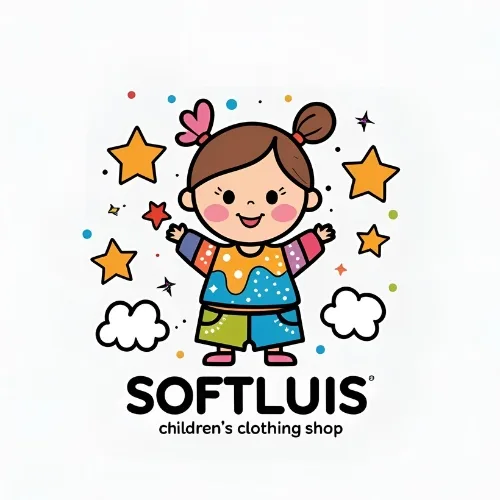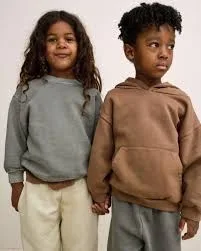News
Sustainable Fashion for Kids
Part 1: The Green Wardrobe Revolution – Why Organic Cotton and Bamboo are the Future of Kids’ Fashion
Introduction: Beyond Cute – The Imperative for Sustainable Kids’ Clothing
The modern consumer is more conscious than ever, not only about what their children wear but also how those clothes are made and what impact they have on the planet and the child’s body. The fast fashion cycle, marked by cheap materials, toxic dyes, and rapid turnover, is facing a strong backlash, particularly in the sensitive realm of children’s apparel.
This movement has given rise to “Green Fashion” or Sustainable Kids’ Wear, where the choice of fabric is paramount. Parents are actively seeking materials that are gentle on their child’s delicate skin, capable of handling the rigors of play, and kind to Mother Earth. Leading this charge are two superstar sustainable textiles: Organic Cotton and Bamboo Fiber.
This comprehensive piece will delve into why these two materials are redefining children’s wardrobes, offering a deep-dive into their unparalleled benefits for skin health, performance, and environmental stewardship.
I. The Core of the Problem: Why Traditional Cotton Falls Short
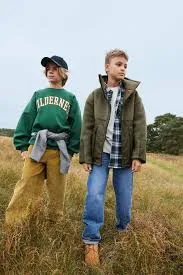
Before celebrating the sustainable alternatives, it is crucial to understand the issues inherent in conventional cotton production—the material that dominates most children’s clothing sections.
A. Chemical Load and Skin Irritation
Conventional cotton is notoriously one of the most chemically intensive crops globally.
- Pesticides and Insecticides: It requires vast amounts of synthetic fertilizers, pesticides, and insecticides. Residues of these chemicals can linger in the final fabric, even after washing.
- Dyeing and Finishing: The post-harvest process involves aggressive bleaching, formaldehyde treatments for wrinkle resistance, and often relies on heavy metal-based synthetic dyes.
- The Dermatological Risk: For babies and young children with highly permeable and sensitive skin, exposure to these chemical residues is a significant concern. They can trigger allergic reactions, eczema flare-ups, dermatitis, and respiratory issues. This chemical exposure directly compromises the promise of a safe, comfortable garment.
B. Environmental Devastation
The environmental cost of conventional cotton is equally steep. It is a major contributor to water scarcity (being extremely thirsty), soil degradation, and water pollution due to chemical runoff. Choosing an alternative is therefore a direct environmental action.
II. Organic Cotton: The Clean, Trusted Champion
Organic Cotton is grown without the use of toxic pesticides, synthetic fertilizers, or genetically modified seeds (GMOs). It is widely regarded as the gold standard for children’s wear due to its purity and gentleness.
A. Unmatched Skin Health Benefits (Dermatology Focus)
The primary reason parents choose organic cotton is its direct link to superior skin health.
- Hypoallergenic by Nature: Since the fibers are grown without chemical inputs, they are naturally hypoallergenic. This drastically reduces the likelihood of skin irritation, redness, or allergic reactions, making it the top recommendation for babies and children prone to eczema, sensitive skin, or contact dermatitis.
- Fiber Purity and Breathability: Organic cotton fibers are typically softer and stronger because they haven’t been weakened by harsh chemical treatments. This purity allows the fiber to retain its natural structure, which maximizes its breathability. Air circulates freely through the fabric, preventing moisture buildup and keeping the skin dry and cool—a key defense against heat rash and yeast infections in skin folds.
- No Residual Toxins: Certified organic cotton production often follows strict standards (like GOTS – Global Organic Textile Standard) that also dictate the use of non-toxic, low-impact dyes and prohibit harmful finishing chemicals. This ensures the final garment is as clean as the raw material.
B. Performance and Durability
While comfort is key, organic cotton also performs exceptionally well for active children.
- Softness that Lasts: Organic fibers are hand-picked, which preserves the integrity of the cotton. This results in a material that is not only soft to the touch but often gets softer with every wash, making it ideal for items that see heavy rotation, like sleepwear and everyday basics.
- Excellent Absorbency: Like traditional cotton, organic cotton is naturally highly absorbent, efficiently soaking up sweat and moisture during play or sleep, then releasing it, which aids in temperature regulation.
- Superior Durability: Due to the stronger, less damaged fibers, organic cotton garments tend to be more durable and long-lasting than their conventional counterparts, perfectly supporting the hand-me-down culture essential to sustainable parenting.
C. Environmental Stewardship (Sustainability Focus)
Choosing organic cotton is a powerful vote for ecological health.
- Water Conservation: Organic farming practices utilize rainwater far more effectively than conventional methods, leading to a significant reduction in water consumption—up to 91% less “blue water” (irrigation water) compared to conventional cotton.
- Healthy Soil and Biodiversity: Organic agriculture builds healthy, living soil through crop rotation and natural composting. Healthy soil acts as a carbon sink, pulling CO2 from the atmosphere and storing it, which is crucial for fighting climate change. It also supports higher levels of biodiversity.
- Worker Health and Safety: By eliminating the use of toxic pesticides, organic farming protects the health of the cotton farmers and their communities, ensuring a safer work environment and cleaner local water sources.
III. Bamboo Fiber: The Hypoallergenic, Thermo-Regulating Miracle
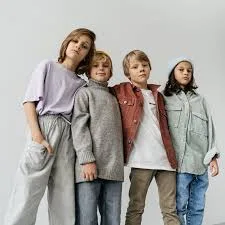
Bamboo Fiber (often referred to as Bamboo Viscose or Lyocell) has exploded in popularity, especially for baby and toddler wear, due to its luxurious feel and exceptional performance characteristics.
A. Performance Powerhouse (Absorbency & Comfort Focus)
Bamboo fabric offers a unique combination of comfort and high-tech performance unmatched by most natural fibers.
- Unbelievable Softness and Drape: Bamboo fiber is known for its incredible softness, often compared to silk or cashmere. It has a beautiful natural drape that feels exceptionally light and cool against the skin, minimizing friction and irritation.
- Thermo-Regulating Properties: Bamboo is perhaps best known for its ability to regulate temperature. Its cross-section is filled with micro-gaps and micro-holes, which enhance the fabric’s ability to pull moisture away from the body (wicking) and facilitate ventilation.
- Keeps Cool in Summer: This wicking ability means sweat is quickly drawn away and evaporated, making it feel several degrees cooler than cotton in warm weather.
- Keeps Warm in Winter: The same structure traps warm air close to the body, providing insulation during colder months. This adaptability is priceless for infants who struggle to regulate their own body temperature.
- Superior Moisture Absorption (Wicking): Bamboo fiber can absorb moisture much faster than traditional cotton, making it perfect for baby towels, cloth diaper inserts, and children’s sportswear.
B. Skin Health and Antibacterial Qualities
The structure and natural properties of bamboo offer significant dermatological advantages.
- Naturally Antibacterial: Bamboo contains a natural bio-agent called “Bamboo Kun,” which gives the fiber antibacterial and antifungal properties. This feature is crucial for children’s clothing, as it helps resist odors, prevents the growth of bacteria (which can exacerbate skin conditions), and keeps the garment feeling fresh for longer.
- Reduced Friction: Due to its silky smoothness, bamboo fabric has low surface friction. For a child with eczema or sensitive, inflamed skin, reducing friction is key to preventing further irritation and allowing the skin to heal.
C. Environmental Benefits (Rapid Renewal and Low Input)
Bamboo is heralded as one of the world’s most sustainable resources.
- Rapid, Self-Renewing Growth: Bamboo is technically a grass and is the fastest-growing plant on Earth. It can regenerate incredibly quickly, often without the need for replanting, making its harvest cycle remarkably short and sustainable.
- Minimal Input Requirements: It requires no pesticides or fertilizers to thrive and needs very little water compared to cotton. It can grow densely in poor soil, helping to regenerate degraded land.
- Soil Stability and Carbon Sequestration: The extensive root network of bamboo prevents soil erosion. Furthermore, bamboo forests are exceptionally efficient at sequestering carbon dioxide, making them a vital tool in mitigating climate change
Part 2: Synthesis and Future Outlook – Integrating Organic Cotton and Bamboo in Sustainable Kids’ Fashion
IV. Organic Cotton vs. Bamboo Fiber: A Strategic Comparison
While both textiles are pioneers of sustainable fashion, they each possess unique characteristics that make them suitable for different types of children’s apparel. Understanding the subtle differences is key for brands and consumers alike when designing a truly green wardrobe.
A. Key Differences in Hand-Feel and Drape
B. Differences in Environmental Footprint (The Processing Debate)
The environmental benefits of Organic Cotton are straightforward: zero chemical inputs in farming. For Bamboo, the sustainability debate lies in the processing method.
- Bamboo Viscose (Rayon): The most common method uses a chemical process (e.g., carbon disulfide) to dissolve the bamboo pulp. While the bamboo plant is highly sustainable to grow, this traditional process can raise environmental concerns regarding chemical emissions if not managed in a closed-loop system.
- Bamboo Lyocell: This is the superior, next-generation method. It uses a non-toxic solvent (amine oxide) and operates in a closed-loop system where up to 99% of the water and solvent are recovered and reused. This process makes Lyocell-based bamboo fabric highly sustainable from both the cultivation and manufacturing stages.
Conclusion for Consumers: When choosing bamboo, look for certifications or product descriptions that specify Bamboo Lyocell or explicitly state that the product was made using a closed-loop process to ensure maximum environmental integrity.
C. Performance in Blends
Many of the highest-performing children’s garments utilize blends to capture the best qualities of both:
- Organic Cotton + Spandex (Elastane): Adds stretch and shape retention to durable basics, perfect for leggings and activewear.
- Bamboo Fiber + Organic Cotton: Combines the silkiness and superior moisture-wicking of bamboo with the familiar strength and structure of cotton, creating an exceptionally soft and highly functional fabric for all-season use.
V. Ethical Manufacturing and Certifications – Ensuring True “Green” Claims
In the highly competitive market of sustainable children’s wear, parents must look beyond marketing terms like “natural” or “eco-friendly” to verifiable third-party certifications. These labels guarantee that the claims extend beyond the raw material to the entire supply chain.
A. The Global Organic Textile Standard (GOTS)
GOTS is the world’s leading processing standard for textiles made from organic fibers. A GOTS certification guarantees:
- Organic Status of Raw Material: Verified organic content (minimum 70% or 95% certified organic fibers).
- Environmental Criteria: No toxic heavy metals, formaldehyde, or aromatic solvents used. Strict controls on wastewater treatment.
- Social Criteria: Mandates fair labor practices, safe working conditions, and no child labor, ensuring the garment is ethically made from farm to finished product.
B. OEKO-TEX Standard 100
While OEKO-TEX does not certify organic status, it is critical for skin health. It certifies that every component of the product, from the fabric itself to the thread and button, has been tested for harmful substances and that the garment is harmless to human health. For children’s wear, especially for infants (Class I), this certification is a non-negotiable safety marker against residual chemicals and dyes.
C. Fair Trade Certification
This certification focuses on the social pillar of sustainability, ensuring that farmers and garment workers receive fair wages and work in safe, democratic conditions. For ethical consumption, clothing with this certification ensures that the people who made the garment were treated justly.
VI. The Long-Term Economic and Environmental Case for Investment
While sustainable clothing often carries a higher initial price tag than fast fashion, the long-term value proposition is robust, especially for a rapidly growing child.
A. The Economics of Durability and Hand-Me-Downs
- Increased Longevity: Organic cotton and high-quality bamboo fabrics are built to last. They resist holes, maintain their shape, and stand up to hundreds of washing cycles better than cheap, conventional fibers.
- High Resale Value: Due to their superior quality and ethical sourcing, sustainable garments hold their value well in the second-hand market. This creates a circular economy: a parent can recoup a portion of the initial investment by selling clothes their child has outgrown.
- Seamless Sibling Sharing: The durability and often gender-neutral design of sustainable lines make them perfect hand-me-downs, significantly reducing the overall cost per wear across multiple children.
B. Ecological Impact Multiplier
The decision to buy a sustainable item has a compounding positive effect:
- Reduced Landfill Waste: Longer-lasting clothes mean fewer items are purchased and discarded, directly reducing the volume of textile waste sent to landfills.
- Lower Carbon Footprint per Wear: Since the garment is worn and reused more times, the initial carbon and water footprint associated with its production is distributed over a longer period, making the ecological cost per wear substantially lower.
- Market Pressure: Every purchase of certified organic cotton or closed-loop bamboo fiber signals to the broader fashion industry that consumers demand cleaner, safer, and ethical supply chains, accelerating the shift away from toxic, resource-intensive production methods.
VII. Integrating the Green Wardrobe into Modern Parenting
The shift to a green wardrobe is a journey, not a destination, and it integrates seamlessly with modern parenting goals focused on health and environmental awareness.
A. A Focus on Minimalist Wardrobes
Sustainable fashion naturally encourages conscious consumerism and minimalism. Instead of buying many low-quality, trend-driven items, parents invest in fewer, high-quality, versatile pieces. This reduces decision fatigue and focuses the family’s resources on items that truly last and serve a functional purpose.
B. Teaching Environmental Responsibility
Choosing organic and bamboo clothing provides a tangible way to teach children about environmental stewardship from an early age.
- Story of the Shirt: Parents can explain that the pajamas they wear help protect the farmers and the earth because they were grown without harmful chemicals. This links consumption directly to values and ethics.
- The Circular Loop: Involving children in the process of donating, swapping, or selling their outgrown high-quality clothes teaches them the principles of the circular economy.
Conclusion: The Gentle Choice for a Better Tomorrow
The movement toward Organic Cotton and Bamboo Fiber in children’s fashion is more than just a trend; it is an informed, ethical response to the needs of the modern child and the contemporary planet.
By selecting these materials, parents make a powerful three-part commitment:
- To Skin Health: Guaranteeing the gentlest touch, free from toxins and optimized for breathable comfort, essential for the most sensitive skin.
- To Performance: Ensuring clothes are highly durable, exceptionally soft, and possess superior thermo-regulating and moisture-wicking properties, perfectly suited for the boundless energy of childhood.
- To the Planet: Supporting agricultural practices that conserve water, build healthy soil, and protect the air, while embracing fast-renewing resources like bamboo.
Ultimately, the Green Wardrobe Revolution is about making choices that align the well-being of our children today with the health of the world they will inherit tomorrow. It is the gentle choice for a better future.
Part 3: Action Strategies and Conclusion – Making the Green Choice the New Standard
VIII. Practical Strategies for the Conscious Consumer
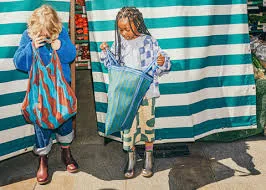
Making the switch to a sustainable wardrobe for children involves conscious choices beyond just selecting the fabric type. Here are actionable strategies for parents committed to green fashion.
A. Prioritizing Quality over Quantity (The ‘Buy Less, Choose Well’ Mantra)
The single most effective sustainable practice is reducing overall consumption.
- Investment Pieces: Focus investment on basics and essentials that are worn frequently and require high durability (e.g., underwear, sleepwear, everyday leggings/trousers). These are the items where the health and environmental benefits of Organic Cotton and Bamboo Fiber offer the highest returns.
- The Capsule Wardrobe Approach: Adopt a capsule wardrobe where items are interchangeable, reducing the need for excessive clothing. The neutral color palettes often favored by sustainable brands naturally support this approach.
B. Extending the Life Cycle of Garments
Sustainability doesn’t end when the item is purchased; it is maintained through care and reuse.
- Optimal Care: Follow the specific care instructions for bamboo (often cool wash and air dry) and organic cotton to maintain their fiber integrity, softness, and extend their usable life for hand-me-downs. Proper care significantly reduces the need to repurchase.
- Embracing the Circular Economy: Actively participate in the circular economy by using local clothing swaps, donating high-quality items to family and friends, or utilizing resale platforms dedicated to children’s sustainable clothing. This ensures the valuable fibers continue to be used and avoids the landfill.
C. Decoding the Labels and Certifications
As discussed, certifications are crucial. Parents should actively seek out and support brands that display:
- GOTS (Global Organic Textile Standard) Certified: Guarantees both organic material and ethical, non-toxic processing.
- OEKO-TEX Standard 100 (Class I): Ensures the garment is free from harmful levels of substances, a critical safety check for baby and toddler wear.
- Closed-Loop Lyocell Process: Specifically for Bamboo Fiber, this confirms environmentally responsible manufacturing.
IX. Driving Innovation: The Role of Manufacturers and Retailers
The long-term success of sustainable kids’ wear depends on the commitment of the fashion industry to make these materials the default, not the premium niche.
A. Scaling Sustainable Production
Manufacturers must invest in:
- Expanding Organic Farming Infrastructure: Supporting farmers globally to transition to organic cotton cultivation through financial incentives and training programs.
- Implementing Closed-Loop Systems: Transitioning all bamboo processing to the less toxic and highly efficient Lyocell method.
- Price Parity Goals: Actively working to reduce the cost gap between conventional and sustainable textiles through efficiency and scale, making the “Green Choice” accessible to all income levels.
B. Transparent Supply Chains
Brands must practice radical transparency. Consumers want to know the origin of the fiber, the location of manufacturing, and the labor conditions. Digital tools, such as QR codes on clothing tags that link to the supply chain story, are key to building consumer trust in the authenticity of “Green Fashion” claims.
Conclusion: The Gentle Choice for a Better Tomorrow
The movement toward Organic Cotton and Bamboo Fiber in children’s fashion is more than just a trend; it is an informed, ethical response to the needs of the modern child and the contemporary planet.
By selecting these materials, parents make a powerful three-part commitment:
- To Skin Health: Guaranteeing the gentlest touch, free from toxins and optimized for breathable comfort, essential for the most sensitive skin.
- To Performance: Ensuring clothes are highly durable, exceptionally soft, and possess superior thermo-regulating and moisture-wicking properties, perfectly suited for the boundless energy of childhood.
- To the Planet: Supporting agricultural practices that conserve water, build healthy soil, and protect the air, while embracing fast-renewing resources like bamboo.
Ultimately, the Green Wardrobe Revolution is about making choices that align the well-being of our children today with the health of the world they will inherit tomorrow. It is the gentle choice for a better future, moving sustainable kids’ wear from an alternative to the unwavering standard.
